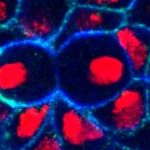Link to Pubmed [PMID] – 16228010
Nat. Cell Biol. 2005 Nov;7(11):1083-90
Localization and activation of heterotrimeric G proteins have a crucial role during asymmetric cell division. The asymmetric division of the Drosophila sensory precursor cell (pl) is polarized along the antero-posterior axis by Frizzled signalling and, during this division, activation of Galphai depends on Partner of Inscuteable (Pins). We establish here that Ric-8, which belongs to a family of guanine nucleotide-exchange factors for Galphai, regulates cortical localization of the subunits Galphai and Gbeta13F. Ric-8, Galphai and Pins are not necessary for the control of the anteroposterior orientation of the mitotic spindle during pl cell division downstream of Frizzled signalling, but they are required for maintainance of the spindle within the plane of the epithelium. On the contrary, Frizzled signalling orients the spindle along the antero-posterior axis but also tilts it along the apico-basal axis. Thus, Frizzled and heterotrimeric G-protein signalling act in opposition to ensure that the spindle aligns both in the plane of the epithelium and along the tissue polarity axis.

